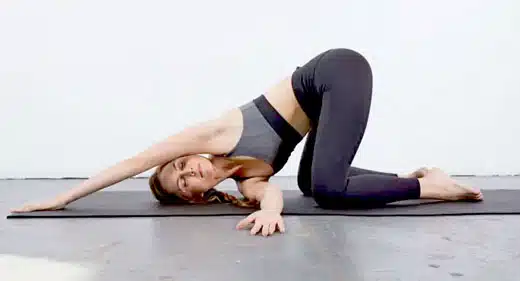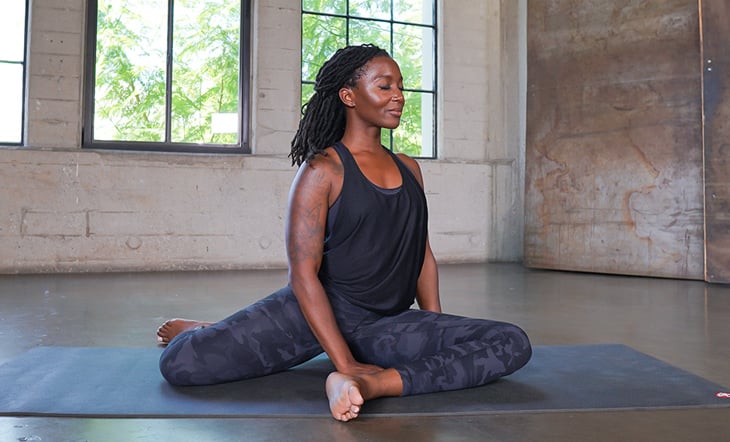One of the things that makes yoga so great is that anyone can do it because of its variety of styles and ways to practice!
 From intense poses to calming flows, the difference from one type of yoga to another can be huge.
From intense poses to calming flows, the difference from one type of yoga to another can be huge.
But there are two styles where the difference is not as obvious and are often confused as being the same: many people wonder what is the difference between Yin Yoga and Restorative Yoga.
When it comes to Yin versus Restorative Yoga, there are a few things that you need to know.
Yin Versus Restorative Yoga: Here’s What You Need to Know About Each Yoga Style
So, what’s the scoop on these two ways to practice yoga? And why does the difference between Yin and Restorative Yoga really matter?
Let’s learn the difference between these types of yoga and how adding them to your weekly schedule can be transformational!
So, let’s dive in. But, first, a little background.
Yin Yoga
Although most styles of yoga have their origin in India, Yin Yoga has ties to the Chinese Taoist concept of Yin and Yang.
The idea is that there are two different forces of energy called Yang and Yin. Yang energy is characterized as masculine, sun, active, bright, and movement. And Yin energy is characterized as feminine, moon, calm, night, dark, and stillness.
Though Taoist practices of movement similar to Yin have been around for millennia, the founding of Yin Yoga as a form of practice wasn’t until 1980 when Paulie Zink, a martial arts champion in the U.S., invented it by synthesizing Taoist principles and Hatha Yoga in creating his own yoga postures.
What Is Yin Yoga and What Are the Most Common Benefits?
Unlike yoga styles that could be considered more Yang, moving quickly through postures with an emphasis on building muscle, Yin takes the exact opposite approach, staying still in poses while targeting the fascia and connective tissues.
Postures are held for at least a minute and typically as long as four to eight minutes, allowing for a deep release both mentally and physically. Zink also ties Yin Yoga into the Chinese Five Elements of Metal, Fire, Earth, Water, and Wood, working with the energy referred to as Chi in the body.
Sounds easy right? Just hold the poses and close your eyes? Might as well catch a nap. Well, the truth is Yin Yoga can be a very challenging form of yoga!
Yin can be an intense stretch that will push your comfort level. For those just learning, there are always plenty of ways to modify the stretches to make them more manageable.
But there is always the opportunity in a Yin class to stretch gently beyond your comfort level to gain greater flexibility and mobility. Doing this takes a lot of mental and physical discipline.
Using the breath to find mental stillness and connect to that inner energy is another aspect of Yin Yoga that can have you walking away from the practice feeling like a new person.
Ready to Practice Yin Yoga?
Practice Simply Yin Yoga with renowned Yin teacher Ashley Limehouse on YA Classes!

Restorative Yoga
Restorative Yoga has the word root “restore,” meaning to heal or replenish. And true to its name, that’s what Restorative Yoga is all about.
Originating from the Iyengar Yoga linage, Restorative was intended for recovery and healing. It was created as a form of yoga that is perfect to do after an injury or to switch out of a stressful state and into our parasympathetic nervous system, for resting and digesting.
In Restorative Yoga classes, props are used to support the body in being able to fully relax. Even though a lot of the movements are quite subtle, it targets specific areas of the body where it can work deeply to allow for complete relaxation throughout the muscles in that area.
In Restorative Yoga, you can hold the poses for a minimum of five minutes or even as long as 20 minutes. However long you hold the poses, you will end up finishing your practice feeling nurtured and “restored!”
Curious About Restorative Yoga? We Answer 7 Questions You’ve Always Wanted to Ask
Ready to Practice Restorative Yoga?
Practice Restore with our Restorative Yoga specialist, Allie Geer on YA Classes!

Yin Versus Restorative Yoga: What Are the Key Similarities and Differences?
So why are Restorative and Yin Yoga so commonly confused?
The main similarity in the styles is that poses are held for an extended amount of time, there is a focus on connecting to the breath, they help to let go of stress, and are incredibly beneficial for our physical and mental health.
Because of this, these two styles are often thought of as that one “slow yoga class.” But beyond these foundational similarities, there are some significant things that make Yin versus Restorative Yoga very drastically different!
While practicing Yin Yoga, the intention is not to relax but to deeply release the body and mind through somewhat difficult postures.
In Yin poses, we find stillness within, not necessarily relaxation in the process of actively working the connective tissues, fascia, ligaments, and joints.
The 26 Yin Yoga poses are similar to Yang-style poses and include postures like Butterfly and Pigeon, which you also see in typical Vinyasa classes. The difference is the length of time that you hold them.
Restorative Yoga poses are not ones that you would see commonly practiced in a typical flow yoga class. The poses are mostly done low down to the mat and with many props.
In Restorative Yoga, the goal is to let go of the need to set a goal or push yourself. Instead, the focus is on supporting the body where it’s at to relax and allow for healing. Props are used to assist with coming into a state of complete relaxation.
Yin Versus Restorative Yoga: How Do You Know Which One Is for You?
Now that we’ve covered the differences of Yin versus Restorative Yoga and what they are all about, it’s time to get to the good part! Why adding one of these practices to our weekly schedule can change how we relate to ourselves, others, and the world.
Busy, busy, busy – the state we are in a lot of the time. We rush to and from places, meeting friends, working and living life to the fullest. This is all activating the sympathetic nervous system, the fight-or-flight system, which activates our bodies to respond quickly in emergency situations.
This can be really useful in emergencies, but when we’re constantly in this state for the sake of getting our daily tasks done, it can be too much. Without time to relax, the body can’t let go of stress or anxiety and this can lead to feeling unwell mentally and physically.
We often make doing workouts a priority for getting fit, but when we’re already spending so much time “working out” in daily life it may be better for our well-being to have something more like a “rest-out,” a time where we can relax and let ourselves have a break.
Yin and Restorative Yoga are both great ways to slow down the body and mind and return to your daily life feeling grounded, with renewed energy and mental clarity.
So Yin versus Restorative Yoga – which one and why?
Yin Versus Restorative Yoga – Consider These Points to Determine Which Practice Is for You:
Practicing both is ideal and each will give you a different experience of relaxation and stress relief. But here are a couple of points to help you figure out which one fits you best.
1. Injury or Illness
If you are or have recently been injured or are recovering from an illness, then Restorative Yoga is for you!
The difference between Yin and Restorative Yoga is that, with Yin Yoga, the tissue is actively being worked while the body is still and, with Restorative Yoga, holding the poses allows the body to relax and focus all its energy on restoring.
2. Mobility
If you suffer from muscle tightness and struggle with mobility from stiffness (not injury), then Yin Yoga’s ability to increase overall flexibility is astounding!
Holding the body in Yin poses targets those deep connective tissues. As the body releases, while holding the pose, your stiffness dissolves and mobility increases.
3. Intensity
If you’re working your body intensely on a regular basis and need a break, Restorative Yoga lets the body come into a state of renewal and gives you a chance to counter the stresses of everyday life.
If you do vigorous activities that might have your body in a state of fight-or-flight, spending time relaxing and releasing the muscles can help you avoid injuries, burn-out, or exhaustion of your body’s resources.
4. Stillness
If you have trouble being still or meditating, then both Yin and Restorative are excellent ways to still your mind, connect with your breath, and focus on the present.
From my personal experience, Yin is easier to start with as the postures are all-consuming and require a lot of mental attention, which makes focusing on the breath and being in the present more attainable.
After practicing Yin for several years, I found a love for Restorative Yoga. When in a Restorative class, the long periods of silence, turning to breath and closing the eyes seem natural!
However, without the focus on actively deepening the pose, the mind can be more inclined to wander. If you are new to slow-paced yoga and think you’ll have trouble staying still, start with Yin.
The Takeaway on Yin Versus Restorative Yoga
Now, knowing the difference between Yin and Restorative Yoga, you can incorporate them into your weekly routine!
These two styles of yoga practice have significant differences. Yin is an active, deeply releasing style focused on the tissues. Restorative is about supporting the body to let go of stress and recover from injury.
However, they have one main thing in common: they are both highly beneficial for your overall mental and physical health!
You can incorporate them into your weekly routine as a way to diversify your practice or use them as needed, listening to what your body needs for guidance.









































